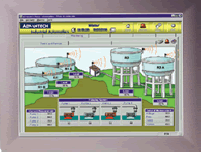M2M Device Networking:
- Home >
- articles >
- automation >
- preventive maintenance technology
Enabling New Possibilities for Preventive Maintenance
By Marty Huff

Today, most businesses rely on networks for sharing information among employees and customers. Yet this is only a small piece of the information that can be shared. Machines and appliances - essentially any electronic or electro-mechanical device with a sensor, controller or microprocessor - contains a great deal of information about its status, performance and usage.
The ability to extract raw data from a device, machine or appliance and convert that data into useful information transforms the decision-making from an art to a science. You can now leverage Internet, Wi-Fi and Celluar technologies to relay information anywhere, anytime. This unique combination of factors has converged into a powerful new paradigm known as M2M (machine-to-machine, machine-to-man and machine-to-mobile). M2M constitutes the next notable phase in preventive maintenance, a phase that opens up a whole new world of possibilities including:
- The ability to know the status of a piece of equipment no matter where you are, by having alerts sent to a web browser, PDA, pager or cell phone.
- The potential to know which part needs repair or replacement before you dispatch a technician, which can save time and money.
- Enhanced tools that provide the ability to analyze and track a machine's history, in order to spot trends and more accurately predict maintenance requirements well in advance.
- For those industries such as wastewater, where accurate regulatory reporting is key, M2M strategies can create and deliver periodic reports automatically and help reduce the likelihood of fines.
For example, a central server can monitor several remote cell phone towers via the Internet. Let's say the beacon light on one of the towers fails. The application running on the server recognizes the failure which triggers a local alarm, sends an email alert over the Internet to the FCC, and forwards a cell phone message to a technician. At that point, the technician can browse to a Web page through a Web-enabled cell phone in order to acknowledge the alarm and enter an estimated time for the repair. Knowing at this point the nature of the repair, the technician responds with the correct parts in hand to repair the light. To top it off, all of this information can be made available to an enterprise software application or authorized company staff.
Using simple plug-and-play modules, you can now connect devices directly into legacy systems and create peer-to-peer device networks, even with many types of equipment that have overlooked in the past. In many cases, it is possible to connect to a single machine and gain access to a majority of facilities equipment.
With M2M device networking, intelligent devices, however remote, are capable of relaying data and sending alerts, alarms, and commands to cell phones, PDAs, databases and other intelligent devices. Devices can also be "Web-enabled" and accessible using a standard Web browser. This article outlines the components required for an M2M system, demonstrating how easy it is to implement an enhanced maintenance management system with just a few basic requirements. For OEM's, an M2M system can provide an incredible opportunity to provide enhanced customer service and distinguish their products from the competition.
M2M Components
There are basically four components in an M2M system: 1) the intelligent device (machine or appliance) where the data originates, 2) the gateway that extracts and translates data, 3) the network which serves the data and 4) the remote client which ultimately receives the data. M2M software applications are optional but can facilitate communications, enable Web access and provide the user interface.
Please See the following pages to continue with this Preventive Maintenance Technology Article...
The Intelligent Device: Where The Data Originates
The Gateway: Translates and Passes The Data To The Network
The Network: The Connectivity That Serves Data To The Remote Client
The Remote Client: The Destination Of The Information
| Marty Huff - MSI Tec, Inc. About the Author: Marty Huff is an IT professional with MSI Tec and can be reached directly at 720-875-9835 or by email at mailto:martyh@msitec.com. MSI Tec is a provider of intelligent machine control components and systems, and the value adding engineering resources for the successful identification and implementation of their use. Marty is responsible for M2M systems design, programming and installation and is available for dedicated training programs and seminars on the subject of M2M. Don Fitchett, Business Industrial Network, contributor to this article. |
See Also
